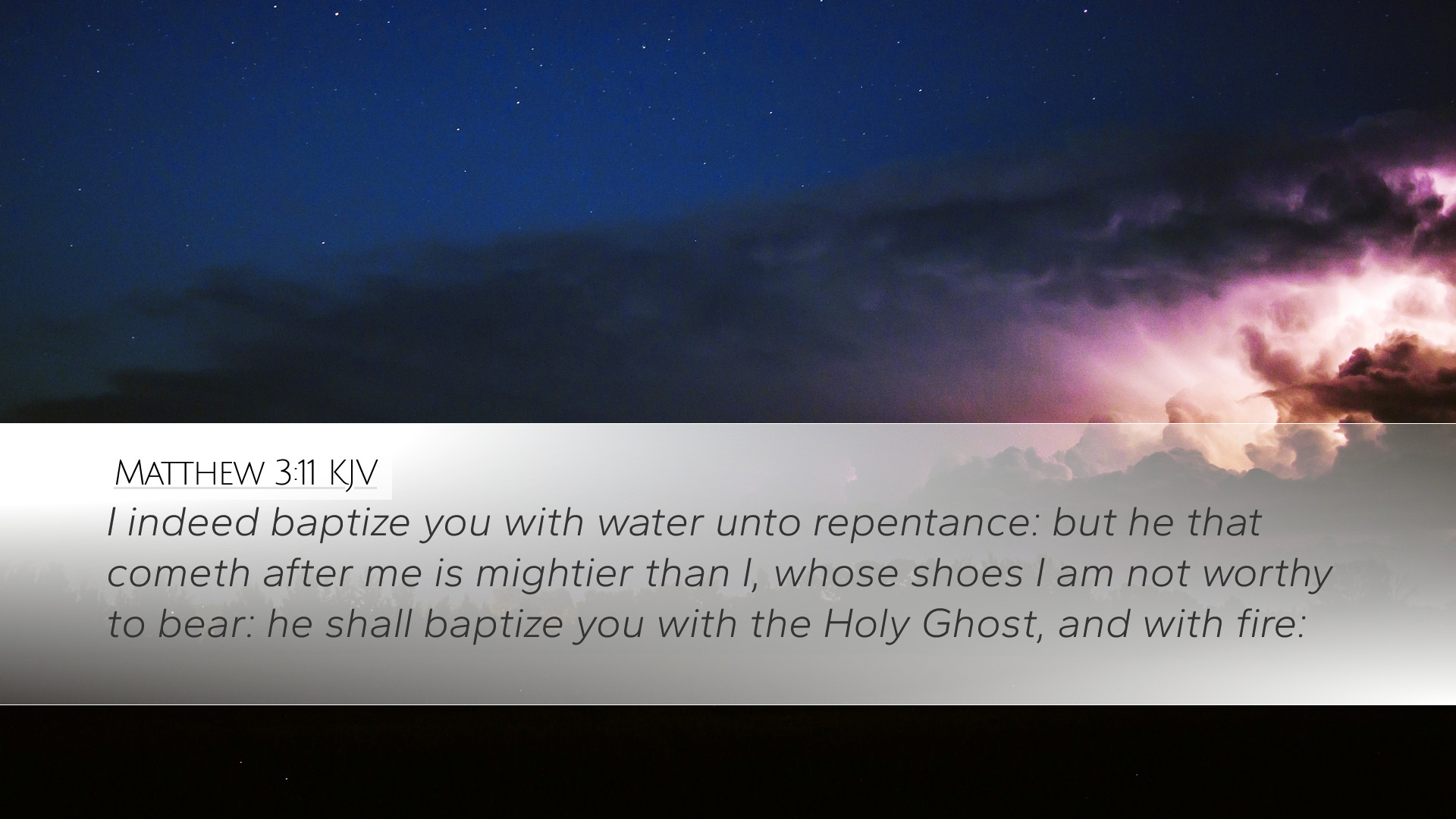Commentary on Matthew 3:11
Bible Verse: Matthew 3:11 - "I indeed baptize you with water unto repentance: but he that cometh after me is mightier than I, whose shoes I am not worthy to bear: he shall baptize you with the Holy Ghost, and with fire."
Introduction
This verse encapsulates the ministry and purpose of John the Baptist as the forerunner to Christ. It provides insights into the nature of true baptism, the holiness of Christ, and the transformative work of the Holy Spirit. The exegetical insights below draw from notable public domain commentaries to enrich understanding for pastors, students, theologians, and Bible scholars.
John the Baptist's Role
Matthew Henry notes that John the Baptist fulfills a prophetic role, serving as the herald of Christ. His baptism with water symbolizes repentance, a preparatory step toward the greater baptism that Christ will offer. This illustrates John’s humble recognition of his position as the precursor, echoing themes from the Old Testament that signify a voice calling in the wilderness.
Albert Barnes elaborates on John's mission, emphasizing the significance of baptism as a public declaration of repentance. This act is not only a physical washing but also signifies a spiritual cleansing, setting the stage for the deeper spiritual work to be accomplished by Jesus. Barnes underscores the idea that John's ministry awakens a consciousness of sin and the need for divine intervention.
Christ's Superiority
Henry poignantly points out John’s statement of Christ's mightiness, which conveys that Jesus' authority surpasses that of any prophet. The imagery of "whose shoes I am not worthy to bear" reflects profound humility on John's part. This phrase suggests that even the most menial service for Christ is beyond John's capacity, illustrating Jesus' divine nature and greatness.
Adam Clarke expands this idea by explaining that the phrase "shoes" pertains to the lowest service in the culture of the time. John's acknowledgment of his unworthiness starkly contrasts the grandeur and holiness of Christ, revealing the infinite gap between human limitations and divine holiness. Clarke emphasizes that Christ's mightiness is established not by external acclaim but by His inherent nature as the Son of God.
The Baptism of the Holy Spirit
The latter part of Matthew 3:11 introduces the concept of Christ baptizing "with the Holy Ghost, and with fire." Henry interprets the baptism of the Holy Spirit as the empowering presence of God that enables believers to live righteously and effectively proclaim the Gospel. This significant distinction between John's water baptism and Christ's baptism indicates a deeper, spiritual cleansing and empowerment for ministry.
Barnes discusses the implications of this 'baptism with the Holy Ghost.' He explains that it reflects the new covenant promise where believers are endowed with spiritual gifts and the ability to live in accordance with God's will. This baptism is not merely ceremonial but transformative, signifying spiritual rebirth and an intimate relationship with God.
Clarke emphasizes that the phrase “and with fire” suggests both purification and judgment. The imagery of fire is significant in biblical literature as it denotes refining, purifying, and the intense presence of God. Thus, while believers receive the Holy Spirit in power and love, there remains a dual significance of purification necessitated by the presence of sin.
Theological Implications
The exegesis of Matthew 3:11 opens substantial theological reflections. The text not only reflects the nature of baptism but also the work of the Holy Spirit in the believer's life. As Henry notes, true repentance is foundational for receiving God's grace and empowerment. Understanding the difference between water baptism and spirit baptism becomes critical as ministries develop within contemporary church contexts.
Barnes adds that recognizing Christ’s might is pivotal for faith and worship practices. Acknowledging the Messiah who surpasses all earthly expectations challenges believers to engage deeply with their faith, emphasizing reliance on God's power for personal transformation and evangelistic endeavors.
Clarke highlights the eschatological dimension, encouraging believers to prepare for the coming judgment, where the fire of Christ’s baptism signifies both cleansing and the separating of true followers from those merely partaking in ritualism. This duality invites reflection on the serious nature of discipleship and the call to holiness within the church.
Conclusion
Matthew 3:11 presents profound truths about the nature of repentance, the supremacy of Christ, and the empowering work of the Holy Spirit. As pastors, students, and theologians engage with this verse, they are reminded of the transformative power that comes from embracing the fullness of baptism in the Holy Spirit. These insights, derived from respected commentators, encourage a deeper exploration of the implications for individual believers and the church as a whole.
Ultimately, this verse serves as a call to humility, reminding us that, like John, we are to prepare the way for the Lord, acknowledging His might and the necessity of His Spirit to ignite true revival and transformation within ourselves and our communities.


